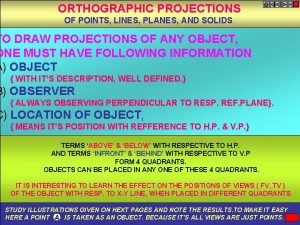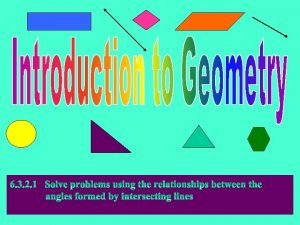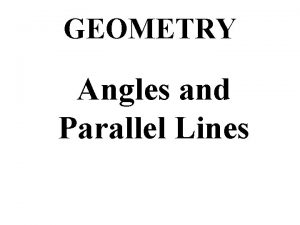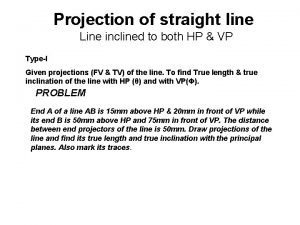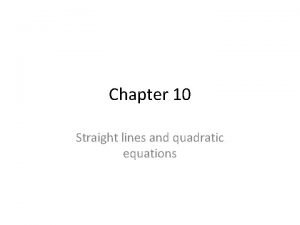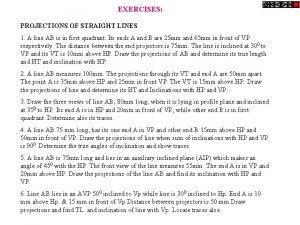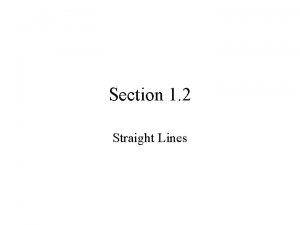EXERCISES PROJECTIONS OF STRAIGHT LINES 1 A line








- Slides: 8

EXERCISES: PROJECTIONS OF STRAIGHT LINES 1. A line AB is in first quadrant. Its ends A and B are 25 mm and 65 mm in front of VP respectively. The distance between the end projectors is 75 mm. The line is inclined at 30 0 to VP and its VT is 10 mm above HP. Draw the projections of AB and determine its true length and HT and inclination with HP. 2. A line AB measures 100 mm. The projections through its VT and end A are 50 mm apart. The point A is 35 mm above HP and 25 mm in front VP. The VT is 15 mm above HP. Draw the projections of line and determine its HT and Inclinations with HP and VP. 3. Draw the three views of line AB, 80 mm long, when it is lying in profile plane and inclined at 350 to HP. Its end A is in HP and 20 mm in front of VP, while other end B is in first quadrant. Determine also its traces. 4. A line AB 75 mm long, has its one end A in VP and other end B 15 mm above HP and 50 mm in front of VP. Draw the projections of line when sum of inclinations with HP and VP is 900. Determine the true angles of inclination and show traces. 5. A line AB is 75 mm long and lies in an auxiliary inclined plane (AIP) which makes an angle of 450 with the HP. The front view of the line measures 55 mm. The end A is in VP and 20 mm above HP. Draw the projections of the line AB and find its inclination with HP and VP. 6. Line AB lies in an AVP 500 inclined to Vp while line is 300 inclined to Hp. End A is 10 mm above Hp. & 15 mm in front of Vp. Distance between projectors is 50 mm. Draw projections and find TL and inclination of line with Vp. Locate traces also.

APPLICATIONS OF LINES Room , compound wall cases 7) A room measures 8 m x 5 m x 4 m high. An electric point hang in the center of ceiling and 1 m below it. A thin straight wire connects the point to the switch in one of the corners of the room and 2 m above the floor. Draw the projections of the and its length and slope angle with the floor. 8) A room is of size 6 m5 m3. 5 m high. Determine graphically the real distance between the top corner and its diagonally apposite bottom corners. consider appropriate scale 9) Two pegs A and B are fixed in each of the two adjacent side walls of the rectangular room 3 m x 4 m sides. Peg A is 1. 5 m above the floor, 1. 2 m from the longer side wall and is protruding 0. 3 m from the wall. Peg B is 2 m above the floor, 1 m from other side wall and protruding 0. 2 m from the wall. Find the distance between the ends of the two pegs. Also find the height of the roof if the shortest distance between peg A and center of the ceiling is 5 m. 10) Two fan motors hang from the ceiling of a hall 12 m x 5 m x 8 m high at heights of 4 m and 6 m respectively. Determine graphically the distance between the motors. Also find the distance of each motor from the top corner joining end and front wall. 11) Two mangos on a two tree are 2 m and 3 m above the ground level and 1. 5 m and 2. 5 m from a 0. 25 m thick wall but on apposite sides of it. Distances being measured from the center line of the wall. The distance between the apples, measured along ground and parallel to the wall is 3 m. Determine the real distance between the ranges.

POLES, ROADS, PIPE LINES, , NORTH- EAST-SOUTH WEST, SLOPE AND GRADIENT CASES. 12)Three vertical poles AB, CD and EF are lying along the corners of equilateral triangle lying on the ground of 100 mm sides. Their lengths are 5 m, 8 m and 12 m respectively. Draw their projections and find real distance between their top ends. 13) A straight road going up hill from a point A due east to another point B is 4 km long and has a slop of 250. Another straight road from B due 300 east of north to a point C is also 4 kms long but going downward and has slope of 150. Find the length and slope of the straight road connecting A and C. 14) An electric transmission line laid along an uphill from the hydroelectric power station due west to a substation is 2 km long and has a slop of 300. Another line from the substation, running W 450 N to village, is 4 km long and laid on the ground level. Determine the length and slope of the proposed telephone line joining the power station and village. 15) Two wire ropes are attached to the top corner of a 15 m high building. The other end of one wire rope is attached to the top of the vertical pole 5 m high and the rope makes an angle of depression of 45 0. The rope makes 300 angle of depression and is attached to the top of a 2 m high pole. The pole in the top view are 2 m apart. Draw the projections of the wire ropes. 16) Two hill tops A and B are 90 m and 60 m above the ground level respectively. They are observed from the point C, 20 m above the ground. From C angles and elevations for A and B are 450 and 300 respectively. From B angle of elevation of A is 450. Determine the two distances between A, B and C.

PROJECTIONS OF PLANES: 1. A thin regular pentagon of 30 mm sides has one side // to Hp and 300 inclined to Vp while its surface is 450 inclines to Hp. Draw its projections. 2. A circle of 50 mm diameter has end A of diameter AB in Hp and AB diameter 300 inclined to Hp. Draw its projections if a) the TV of same diameter is 450 inclined to Vp, OR b) Diameter AB is in profile plane. 3. A thin triangle PQR has sides PQ = 60 mm. QR = 80 mm. and RP = 50 mm. long respectively. Side PQ rest on ground and makes 300 with Vp. Point P is 30 mm in front of Vp and R is 40 mm above ground. Draw its projections. 4. An isosceles triangle having base 60 mm long and altitude 80 mm long appears as an equilateral triangle of 60 mm sides with one side 300 inclined to XY in top view. Draw its projections. 5. A 300 -600 set-square of 40 mm long shortest side in Hp appears is an isosceles triangle in its TV. Draw projections of it and find its inclination with Hp. 6. A rhombus of 60 mm and 40 mm long diagonals is so placed on Hp that in TV it appears as a square of 40 mm long diagonals. Draw its FV. 7. Draw projections of a circle 40 mm diameter resting on Hp on a point A on the circumference with its surface 30 0 inclined to Hp and 450 to Vp. 8. A top view of plane figure whose surface is perpendicular to Vp and 600 inclined to Hp is regular hexagon of 30 mm sides with one side 300 inclined to xy. Determine it’s true shape. 9. Draw a rectangular abcd of side 50 mm and 30 mm with longer 350 with XY, representing TV of a quadrilateral plane ABCD. The point A and B are 25 and 50 mm above Hp respectively. Draw a suitable Fv and determine its true shape. 10. Draw a pentagon abcde having side 500 to XY, with the side ab =30 mm, bc = 60 mm, cd =50 mm, de = 25 mm and angles abc 1200, cde 1250. A figure is a TV of a plane whose ends A, B and E are 15, 25 and 35 mm above Hp respectively. Complete the projections and determine the true shape of the plane figure. 0

PROJECTIONS OF SOLIDS 1. Draw the projections of a square prism of 25 mm sides base and 50 mm long axis. The prism is resting with one of its corners in VP and axis inclined at 300 to VP and parallel to HP. 2. A pentagonal pyramid, base 40 mm side and height 75 mm rests on one edge on its base on the ground so that the highest point in the base is 25 mm. above ground. Draw the projections when the axis is parallel to Vp. Draw an another front view on an AVP inclined at 300 to edge on which it is resting so that the base is visible. 3. A square pyramid of side 30 mm and axis 60 mm long has one of its slant edges inclined at 450 to HP and a plane containing that slant edge and axis is inclined at 300 to VP. Draw the projections. 4. A hexagonal prism, base 30 mm sides and axis 75 mm long, has an edge of the base parallel to the HP and inclined at 450 to the VP. Its axis makes an angle of 600 with the HP. Draw its projections. Draw another top view on an auxiliary plane inclined at 500 to the HP. 5. Draw the three views of a cone having base 50 mm diameter and axis 60 mm long It is resting on a ground on a point of its base circle. The axis is inclined at 400 to ground at 300 to VP. 6. Draw the projections of a square prism resting on an edge of base on HP. The axis makes an angle of 300 with VP and 450 with HP. Take edge of base 25 mm and axis length as 125 mm. 7. A right pentagonal prism is suspended from one of its corners of base. Draw the projections (three views) when the edge of base apposite to the point of suspension makes an angle of 300 to VP. Take base side 30 mm and axis length 60 mm. s 8. A cone base diameter 50 mm and axis 70 mm long, is freely suspended from a point on the rim of its base. Draw the front view and the top view when the plane containing its axis is perpendicular to HP and makes an angle of 450 with VP.

CASES OF COMPOSITE SOLIDS. 9. A cube of 40 mm long edges is resting on the ground with its vertical faces equally inclined to the VP. A right circular cone base 25 mm diameter and height 50 mm is placed centrally on the top of the cube so that their axis are in a straight line. Draw the front and top views of the solids. Project another top view on an AIP making 450 with the HP 10. A square bar of 30 mm base side and 100 mm long is pushed through the center of a cylindrical block of 30 mm thickness and 70 mm diameter, so that the bar comes out equally through the block on either side. Draw the front view, top view and side view of the solid when the axis of the bar is inclined at 300 to HP and parallel to VP, the sides of a bar being 450 to VP. 11. A cube of 50 mm long edges is resting on the ground with its vertical faces equally inclined to VP. A hexagonal pyramid , base 25 mm side and axis 50 mm long, is placed centrally on the top of the cube so that their axes are in a straight line and two edges of its base are parallel to VP. Draw the front view and the top view of the solids, project another top view on an AIP making an angle of 450 with the HP. 12. A circular block, 75 mm diameter and 25 mm thick is pierced centrally through its flat faces by a square prism of 35 mm base sides and 125 mm long axis, which comes out equally on both sides of the block. Draw the projections of the solids when the combined axis is parallel to HP and inclined at 300 to VP, and a face of the prism makes an angle of 300 with HP. Draw side view also.

SECTION & DEVELOPMENT 1) A square pyramid of 30 mm base sides and 50 mm long axis is resting on its base in HP. Edges of base is equally inclined to VP. It is cut by section plane perpendicular to VP and inclined at 450 to HP. The plane cuts the axis at 10 mm above the base. Draw the projections of the solid and show its development. 2) A hexagonal pyramid, edge of base 30 mm and axis 75 mm, is resting on its edge on HP which is perpendicular to. VP. The axis makes an angle of 300 to HP. the solid is cut by a section plane perpendicular to both HP and VP, and passing through the mid point of the axis. Draw the projections showing the sectional view, true shape of section and development of surface of a cut pyramid containing apex. 3) A cone of base diameter 60 mm and axis 80 mm, long has one of its generators in VP and parallel to HP. It is cut by a section plane perpendicular HP and parallel to VP. Draw the sectional FV, true shape of section and develop the lateral surface of the containing the apex. 4) A cube of 50 mm long slid diagonal rest on ground on one of its corners so that the solid diagonal is vertical and an edge through that corner is parallel to VP. A horizontal section plane passing through midpoint of vertical solid diagonal cuts the cube. Draw the front view of the sectional top view and development of surface. 5) A vertical cylinder cut by a section plane perpendicular to VP and inclined to HP in such a way that the true shape of a section is an ellipse with 50 mm and 80 mm as its minor and major axes. The smallest generator on the cylinder is 20 mm long after it is cut by a section plane. Draw the projections and show the true shape of the section. Also find the inclination of the section plane with HP. Draw the development of the lower half of the cylinder. 6) A cube of 75 mm long edges has its vertical faces equally inclined to VP. It is cut by a section plane perpendicular to VP such that the true shape of section is regular hexagon. Determine the inclination of cutting plane with HP. Draw the sectional top view and true shape of section. 7) The pyramidal portion of a half pyramidal and half conical solid has a base ofthree sides, each 30 mm long. The length of axis is 80 mm. The solid rest on its base with the side of the pyramid base perpendicular to VP. A plane parallel to VP cuts the solid at a distance of 10 mm from the top view of the axis. Draw sectional front view and true shape of section. Also develop the lateral surface of the cut solid.

8) A hexagonal pyramid having edge to edge distance 40 mm and height 60 mm has its base in HP and an edge of base perpendicular to VP. It is cut by a section plane, perpendicular to VP and passing through a point on the axis 10 mm from the base. Draw three views of solid when it is resting on its cut face in HP, resting the larger part of the pyramid. Also draw the lateral surface development of the pyramid. 9) A cone diameter of base 50 mm and axis 60 mm long is resting on its base on ground. It is cut by a section plane perpendicular to VP in such a way that the true shape of a section is a parabola having base 40 mm. Draw three views showing section, true shape of section and development of remaining surface of cone removing its apex. 10) A hexagonal pyramid, base 50 mm side and axis 100 mm long is lying on ground on one of its triangular faces with axis parallel to VP. A vertical section plane, the HT of which makes an angle of 300 with the reference line passes through center of base, the apex being retained. Draw the top view, sectional front view and the development of surface of the cut pyramid containing apex. 11) Hexagonal pyramid of 40 mm base side and height 80 mm is resting on its base on ground. It is cut by a section plane parallel to HP and passing through a point on the axis 25 mm from the apex. Draw the projections of the cut pyramid. A particle P, initially at the mid point of edge of base, starts moving over the surface and reaches the mid point of apposite edge of the top face. Draw the development of the cut pyramid and show the shortest path of particle P. Also show the path in front and top views 12) A cube of 65 mm long edges has its vertical face equally inclined to the VP. It is cut by a section plane, perpendicular to VP, so that the true shape of the section is a regular hexagon, Determine the inclination of the cutting plane with the HP and draw the sectional top view and true shape of the section.
 True inclination of a line with vp is denoted by
True inclination of a line with vp is denoted by Orthographic projection of points and lines
Orthographic projection of points and lines Line vw and line xy are parallel lines drawing
Line vw and line xy are parallel lines drawing Lines and angles
Lines and angles Turn left turn right go straight on exercises
Turn left turn right go straight on exercises Check line tie line base line
Check line tie line base line Light travels in straight lines
Light travels in straight lines A line inclined to both planes
A line inclined to both planes 10 straight g-line
10 straight g-line

